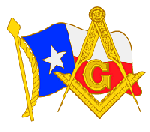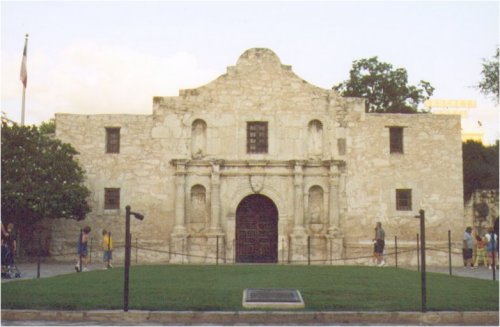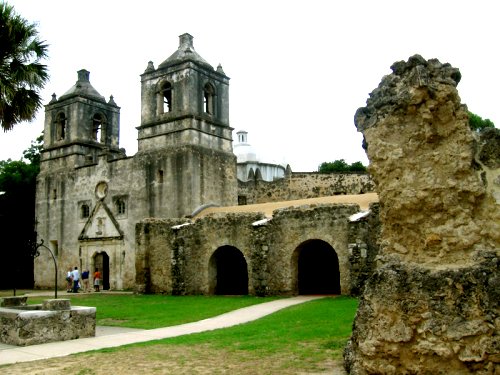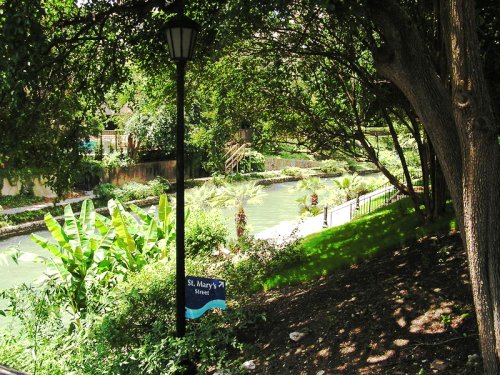 |
Valley Hi Masonic Lodge #1407 A.F. & A.M. San Antonio, Texas |  |

|
Native Americans originally lived in the San Antonio River valley in the San Pedro Springs area, calling the vicinity "Yanaguana," meaning "refreshing waters."
In 1536, Álvar Núñez Cabeza de Vaca, a shipwrecked captive of Native Americans, visited the interior of what would later be called Texas. He saw and described the river later to be named the San Antonio. In 1691, a group of Spanish explorers and missionaries came upon the river and Native American settlement (located in the area of present-day La Villita) on June 13, the feast day of [Saint Anthony of Padova, Italy], and named the place and river "San Antonio" in his honor. In 1716, The Spanish Council of War approved a site on the San Antonio River for construction of a fortified presidio (fort). The Domingo Ramón expedition, accompanied by the trader St. Denis from Louisiana (who had come to the site two years previous) established a presidio on the river. That council also approved a request by Father Olivares to establish a Catholic Mission at the site. In 1718, Martin de Alarcón, then Governor of Texas, reinforced the presidio and the ten soldiers and their families were recognized officially as the beginning of the villa. Alarcón named the presidio San Antonio de Béjar in honor of the Duke of Béjar, in Spain, the viceroy's brother, who died what was considered a hero's death defending Budapest from the Ottoman Empire in 1686 (This is in dispute because there is no such saint). That same year, the Mission of San Francisco de Solano was moved from the Rio Grande to merge with Mission San Antonio de Padua. Father Olivares renamed his merged mission Mission San Antonio de Valero. The presidio, the villa and the mission comprised the municipality named San Antonio de los Llanos (of the Plains) by Governor Alarcón. One year later, in 1719, Mission San Antonio moved to its second site on the east bank near the present day St. Joseph's Church on Commerce. (The names are in dispute because there are no such saints and only a Pope can name saints.)
The Mission San Antonio was moved to its third and final site on Alamo Plaza in 1724 due to hurricane flooding at the previous location. On eleven o'clock on the morning of March 9, 1731, sixteen families (56 people) from the Canary Islands, often referred to as the "Canary Islanders," arrived at the Presidio of San Antonio de Bexar in the Province of Texas. By royal decree of the King of Spain, they founded La Villa de San Fernando and established the first civil government in Texas. The Marquis of Casafuerte, Viceroy of Spain, (King of Spain) bestowed upon each Canary Island family titles of nobility. Many descendants of these first settlers still reside in San Antonio. The missions were all secularized by 1795, and San Antonio de Valero Mission (later, the Alamo) became a military barracks. San Antonio declared for Mexican independence in 1813; it was recaptured by Royalist forces after the battles of Alazán Creek and Medina, and the population was decimated by purges. During the Texas Revolution, San Antonio was the site of several battles, including the siege of Bexar (December 1835) and the battle of the Alamo (March 6, 1836), which made it one of the most fought-over cities in North America. The Battle of the Alamo took place in 1836, and eventually the town would grow to encompass the mission where the battle took place, a mile to the east. This was where 189 defenders, both Mexicans and settlers, were besieged in the old mission against 4,000 Mexican troops led by Antonio López de Santa Anna for 13 days. The defenders were all killed in the final assault on the garrison. Some recent evidence suggests there might have been a few prisoners, Colonel Davy Crockett perhaps among them, that were executed after the battle had ended. The cry "Remember the Alamo" became the rallying point of the Texas Revolution. Texas independence was finally attained at the subsequent Battle of San Jacinto the following April. In 1861 local militia forced the surrender of the federal arsenal at San Antonio even before the state seceded on March 2. Subsequently, San Antonio served as a Confederate depot. Several units such as John S. Ford's Cavalry of the West were formed there, though the city was removed from the fighting.
The Alamo is a shrine and museum located in the heart of downtown, and is surrounded by many hotels and tourist attractions. It is clearly San Antonio's most well-known landmark, and is featured in its flag and seal and in the city's nickname, "Alamo City." Also right by the Alamo is the world famous Crockett Hotel. It is named after the legendary pioneer Davy Crockett. |


